What first comes to mind when you think of Cuba? Thick cigars? Vintage automobiles? While these may well be part of its national identity, there’s so much more to this Caribbean island nation than the stereotypes. On the contrary, Cuba is an intrepid traveler’s dream. But things don’t always run smoothly in Cuba, so you’ll need to come well prepared. Here’s everything you need to know about power adapters and other pro travel tips for Cuba.
US to Cuba Power Adapter: What Plug Do I Need? (2025)
Which power outlets do they use in Cuba?
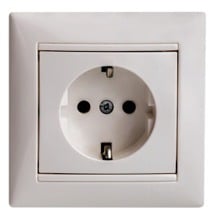
Cuba uses both Type A/B and Type C power outlets. Some hotels will use one type and others another, although plenty use both, sometimes even in the same room! As a result, you’ll have to pack the proper adapter to recharge your devices while on the road.
Power outlets aren’t always safe in Cuba, so always approach with caution when plugging and unplugging your devices. Also, a fuse protected power adapter is advised.
What kind of power adapter do I need for Cuba?
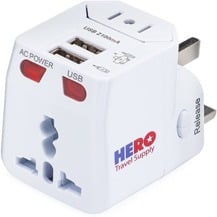
Type A/B is the North American-style twin rectangular prongs. Therefore, in many situations, you’ll be able to plug your device straight into a Cuban socket. Type C, the European-style with twin round prongs, are also common throughout Cuba, so you’ll need a US to Europe Power Adapter to charge your gear.
We recommend bringing this Universal Adapter with you to make sure you will be able to seamlessly charge any of your personal electronics whether you encounter a Type A, B or C outlet during your time in Cuba. In case you experience a power surge, this adapter has a fuse that will protect your devices. It’s also compatible in over 100 countries around the world, so it will likely have you covered on future journeys around the world.
What’s the electricity and power supply like in Cuba?
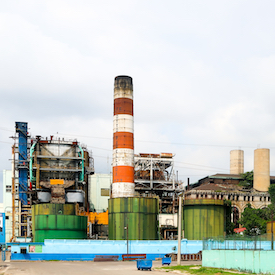
Although Cuba officially runs on 110V, many of the more modern hotels have 110/220V (dual voltage) outlets to cater to the lucrative European market. However, it’s often difficult to determine what the voltage is, so always assume 110V unless it’s explicitly stated otherwise.
Do I Need A Voltage Converter in Cuba?
Almost all personal electronics are dual voltage these days, meaning you can run them on both 110V and 220V.
One of the common exceptions is the portable hairdryer, which tends to be a fixed 110V. Check the label if in doubt. However, since most of Cuba’s outlets are 110V, even your hairdryer should be compatible.
Other Cuba Packing List Items
In addition to your US to Cuba power adapter, these items will help you pack with intention and expand the possibilities of your getaway. Also, check out our Cuba packing list for more inspiration and ideas.
-
1. Neck Wallet / Passport Pouch
Cuba is an impoverished country, meaning some desperate citizens have turned to petty crime to get by. Although muggings and assaults remain rare, pickpocketing and bag snatching have become prevalent in touristy zones.
And considering credit card access is extremely limited across the island, you’ll be forced to carry a lot of cash. The best way to keep your money safe, not to mention your bank cards and passport, is to stash it away in a neck wallet. These breathable and lightweight accessories are comfortable and discreet.
![hero neck wallet]()
-
2. Packing Cubes
Prone to unpacking your clothes into every conceivable corner of your hotel room? Then packing cubes are the ultimate travel accessory for you. These feather-light little plastic cubes are designed to store each clothing type together, allowing even the most disorganized traveler to locate whatever needed with ease.
![aqua packing cubes]()
-
3. Virtual Private Network (VPN)
Although internet access has increased substantially in recent years (3G is finally here!), internet censorship remains rife throughout Cuba. In fact, Reporters Without Borders has listed it as an “internet enemy” ever since it created the global database in 2006. The best way to circumvent government control is by installing a Virtual Private Network on your phone. These nifty apps mask your traffic and allow you to access the internet in its entirety. Additionally, they protect you when you are using public wifi.
![how a vpn works]()
-
4. Lipstick-Sized Charger
Whether you’re snapping a selfie while dancing the Mambo in Havana or navigating your way through Trinidad’s most grandiose colonial constructions, a full battery is a must in Cuba. Ensure you never run flat on the road again by investing in a lipstick-sized charger that slips easily into your purse or onto your key chain.
![Lipstick-Sized Charger]()
-
5. Extra phone charging cables
-
6. Travel Umbrella
-
7. Travel Insurance for Cuba
Cuba may have some of the best doctors in the world, but a perpetual lack of funding means its medical infrastructure leaves a lot to be desired. And should you require an emergency evacuation back to the US, the eye-watering medical bill will leave you bankrupt for life. Don’t take the risk. Invest in a suitable travel insurance policy to safeguard your trip. We recommend TravelInsurance.com because their website makes it easy to compare policies from top companies and find the best option for you and your travel plans.
![Travel Insurance for Cuba]()
Other FAQs about traveling in Cuba
-
1. When to Travel to Cuba?
The best time to visit is during the country’s dry season, which runs between November and April. Rainfall is infrequent at this time, while average daily highs hover at a comfortable 75° to 80°F (24°-27°C). Be sure to check current Cuba travel advisories before you go.
-
2. What’s the weather like in Cuba?
As a tropical Caribbean country, Cuba is (you guessed it) hot and humid.
The mercury drops and the rain stops for the dry season, which is when the majority of tourists visit the country. It can even get surprisingly nippy at night during January and February when the northerly cold fronts roll in.
-
3. What do I need to know about money in Cuba?
I won’t sugar-coat it: managing your money is a massive chore in Cuba. Way back in 1994, the Cuban government devised an ingenious way of extracting as much foreign currency as possible from vacationing gringos via a dual currency system. Consequently, locals can use the Cuban National Peso (CUP) while tourists are forced to use the more expensive Cuban Convertible Peso (CUC).
Although there are a few opportunities for a foreigner to spend CUP such as groceries and public transport, CUC is undoubtedly the most visitor-friendly currency. The CUC is pegged to the USD. The Cuban National Peso, on the other hand, trades at about 26 CUP to 1 USD/CUC. Both currencies look similar, and short-changing scams are commonplace, so be on high alert. Always exchange money at an official CADECA or a branch of the Cuban BFI Bank.
Virtually no local businesses accept credit cards, except for the plushest 5-star hotels. Worse yet, most American issued bank cards won’t work anywhere in Cuba, and offshore credit cards are highly limited at best. As a result, tourists are forced to bring in what they think they’ll spend in cash. Just remember that US dollars are subject to a steep 10% tax, so grab euros, pounds, or Mexican pesos if possible. If you run out of money, cash advances are available from local banks at a whopping 20% commission. I told you it wouldn’t be easy.
-
4. Where to go in Havana?
Most of the capital’s UNESCO-listed sites lie within Havana Vieja (old town), a cobblestoned colonial neighborhood that retains a distinctly Cuban flair. Plaza de la Cathedral is the epicenter, from where a plethora of imposing churches, fortresses, and monuments can be found.
On the edge of the old town is the Capitol Building, a replica of its American counterpart albeit slightly larger and more lavish.
Another interesting political statement is the giant portrait of Che Guevara in his infamous beret, which lies in the adeptly named Plaza de la Revolucion. But to really immerse yourself in Cuban political history, you’ll need to check out the Museum of the Revolution and the Cristóbal Colón Cemetery.
For a taste of quintessential Cuba, hire a vintage automobile to ferry you between the sites. Of course, you’ll want to stop off at a cigar factory, watch a local baseball game, and join an outdoor salsa dance-off to complete the experience. Art lovers won’t want to miss the Gaudi-like installations at Fusterlandia, while book worms can pay a visit to the former residence of Ernest Hemingway. After a long day exploring the city sites, unwind with a mojito or two at the lively Malecon nightlife district or the classy art-deco Hotel Nacional.
-
5. How to Get Around in Cuba?
Air travel is the preferred method of transportation on longer routes. Travelers can purchase tickets through the national carrier Cubana de Aviación, which connects 11 domestic destinations from Havana (all flights go via the capital).
The bus is ideal for shorter stints. Local company Viazul has a fleet of modern coaches that travels to every popular tourist destination in the country.




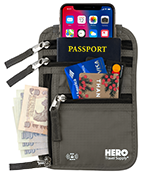




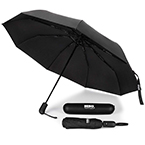

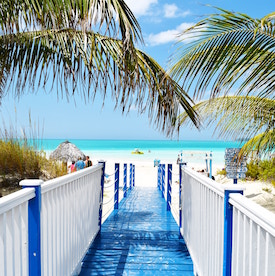 The best time to visit is during the country’s dry season, which runs between November and April. Rainfall is infrequent at this time, while average daily highs hover at a comfortable 75° to 80°F (24°-27°C). Be sure to check current
The best time to visit is during the country’s dry season, which runs between November and April. Rainfall is infrequent at this time, while average daily highs hover at a comfortable 75° to 80°F (24°-27°C). Be sure to check current  Most of the capital’s UNESCO-listed sites lie within Havana Vieja (old town), a cobblestoned colonial neighborhood that retains a distinctly Cuban flair. Plaza de la Cathedral is the epicenter, from where a plethora of imposing churches, fortresses, and monuments can be found.
Most of the capital’s UNESCO-listed sites lie within Havana Vieja (old town), a cobblestoned colonial neighborhood that retains a distinctly Cuban flair. Plaza de la Cathedral is the epicenter, from where a plethora of imposing churches, fortresses, and monuments can be found.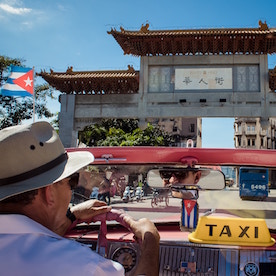 Air travel is the preferred method of transportation on longer routes. Travelers can purchase tickets through the national carrier Cubana de Aviación, which connects 11 domestic destinations from Havana (all flights go via the capital).
Air travel is the preferred method of transportation on longer routes. Travelers can purchase tickets through the national carrier Cubana de Aviación, which connects 11 domestic destinations from Havana (all flights go via the capital).